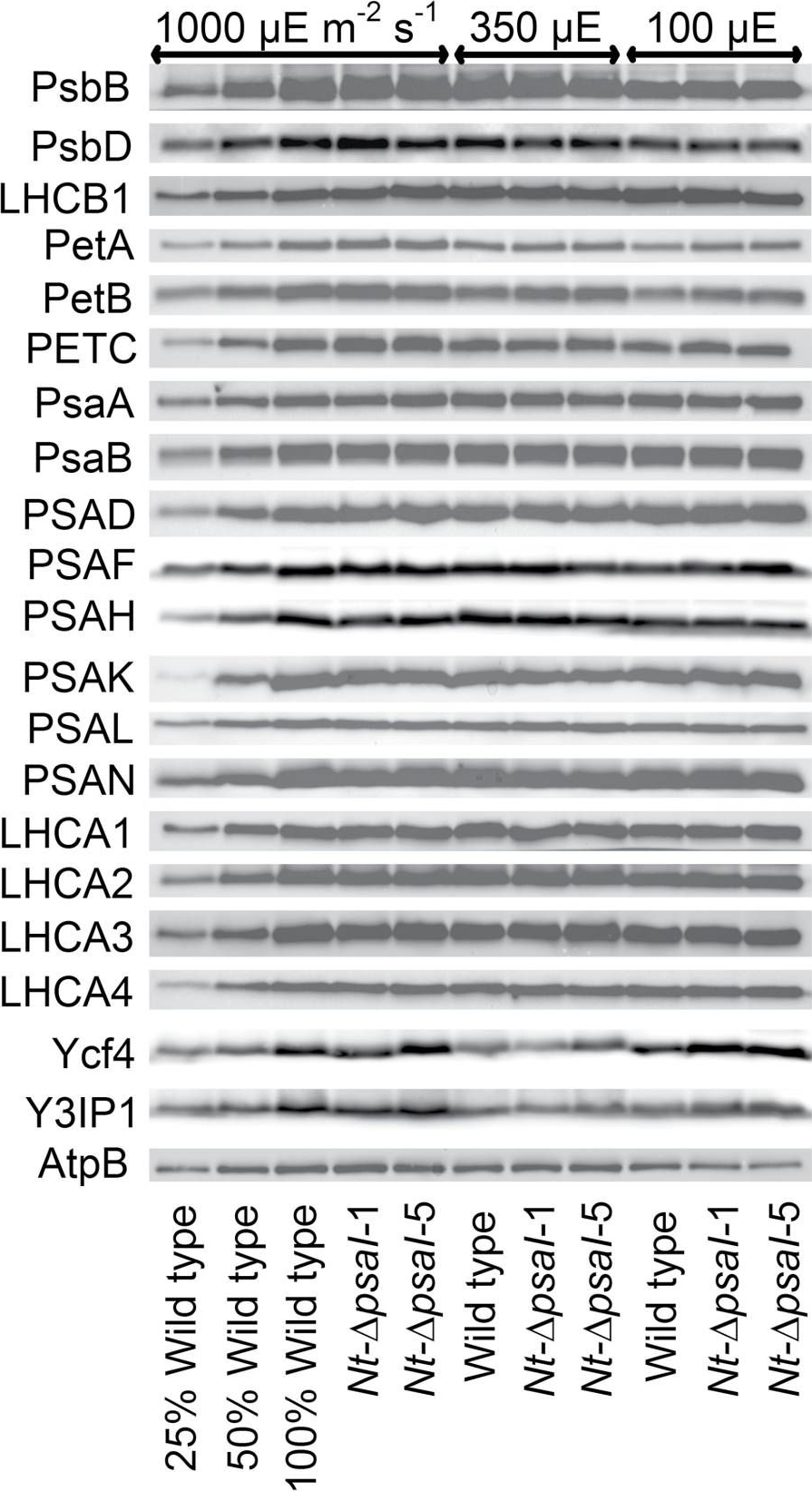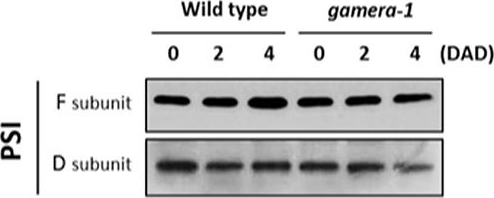1

Anti-PsaF | PSI-F subunit of photosystem I (plant)
AS06 104 | Clonality: Polyclonal | Host: Rabbit | Reactivity: A. thaliana, H. vulgare, N. tabaccum, O. sativa, S. oleracea
- Product Info
-
Immunogen: KLH-conjugated synthetic peptide derived from the PsaF protein sequence of Arabidopsis thaliana (At1g31330). This peptide sequence is not completely conserved in mono- and dicots.
Host: Rabbit Clonality: Polyclonal Purity: Serum Format: Lyophilized Quantity: 50 µl Reconstitution: For reconstitution add 50 µl of sterile water Storage: Store lyophilized/reconstituted at -20°C; once reconstituted make aliquots to avoid repeated freeze-thaw cycles. Please remember to spin the tubes briefly prior to opening them to avoid any losses that might occur from material adhering to the cap or sides of the tube. Tested applications: Western blot (WB) Recommended dilution: 1 : 1000 (WB) Expected | apparent MW: 24 kDa | 17 kDa for Arabidopsis thaliana
- Reactivity
-
Confirmed reactivity: Arabidopsis thaliana, Briopsis corticulans, Hordeum vulgare (very weak), Nicotiana tabaccum, Oryza sativa, Spinacia oleracea Predicted reactivity: Catalpa bungei, Micromonas sp. , Populus trichocarpa, Physcomitrium patens, Ricinus communis
Species of your interest not listed? Contact usNot reactive in: Chlamydomonas reinhardtii, Synechococcus PCC 7942
- Application Examples
-
Application example
<
2 µg of total leaf protein of Arabidopsis thaliana (1) and Hordeum vulgare (2) and total cellular protein of Chlamydomonas reinhardtii (3) and Synechococcus PCC 7942 (4) isolated with PEB (AS08 300) were separated on 4-12% Nupage Bis-Tris gels in in MES running buffer (Invitrogen) at 200V for 35 minutes. Proteins were transferred for 80 minutes at 30V to a PVDF membrane pre-wetted in methanol and equilibrated in 1X transfer buffer. Blots were blocked immediately following transfer in 2% blocking reagent in 20 mM Tris, 137 mM sodium chloride pH 7.6 with 0.1% (v/v) Tween-20 (TBS-T) and probedwith anti-PsaF (AS06 104, 1:1000) and secondary HRP-conjugated goat anti-rabbit antibody (1:50 000) for 1 hr in TBS-T containing 2% ECL Advance blocking reagent (GE Healthcare). Antibody incubations were followed by washings in TBS-T (15, +5, +5, +5 min). All steps were performed at RT with agitation. Signals was detected after 30 s using chemiluminescence detection reagent, according to the manufacturers instructions and a CCD imager (FluorSMax, Bio-Rad).
Application examples: 
Reactant: Nicotiana tabacum (Common tobacco)
Application: Western Blotting
Pudmed ID: 28180288
Journal: J Exp Bot
Figure Number: 5A
Published Date: 2017-02-01
First Author: Schöttler, M. A., Thiele, W., et al.
Impact Factor: 6.088
Open PublicationImmunoblot analysis of photosynthetic complex accumulation in wild-type tobacco and the two ?psaI lines grown under low, intermediate, and high-light conditions. Because the accumulation of most tested proteins was highest under high-light conditions, lanes one to three contain samples diluted to 25%, 50%, and a 100% sample of wild-type tobacco grown under high-light conditions, to allow for semi-quantitative determination of changes in protein abundance. Lanes four and five contain the two transplastomic lines grown at 1000 µE m?2 s?1. Lanes six to eight contain wild-type tobacco and the mutants grown at intermediate light intensities, and lanes nine to eleven contain samples grown at low light intensities. For PSII, the accumulation of the essential subunits PsbB (CP43) and PsbD (D2) and the LHCB1 antenna protein were determined, while for the cytochrome b6f complex, the accumulation of the essential redox-active subunits PetA (cytochrome f), PetB (cytochrome b6), and PETC (Rieske FeS protein) was tested. AtpB was probed as an essential subunit of the chloroplast ATP. For PSI, in addition to the three essential plastome-encoded subunits PsaA, PsaB, and PsaC, the accumulation of the nuclear-encoded subunits PSAD, PSAH, PSAK, PSAL, and PSAN and of the four LHCI proteins (LHCA1, LHCA2, LHCA3, LHCA4) was determined. Finally, we examined the accumulation of Ycf4, the chloroplast-encoded PSI-biogenesis factor encoded in the same operon as PsaI, and the nuclear-encoded assembly factor Y3IP1.

Reactant: Arabidopsis thaliana (Thale cress)
Application: Western Blotting
Pudmed ID: 28791032
Journal: Front Plant Sci
Figure Number: 2A
Published Date: 2017-08-10
First Author: Kohzuma, K., Froehlich, J. E., et al.
Impact Factor: 5.435
Open PublicationChanges in the protein levels of photosynthetic components under extended dark exposure in wild-type and gamera-1. Immunoblot detection of photosynthetic proteins from leaves of Ws and gamera-1 plants incubated after dark adaptation for 0, 2, and 4 days was examined. Specifically, essentially thylakoid fractions were assayed to determine the content of the following proteins: ?-subunit of ATP synthase; the D1 protein, OEC17, OEC23, and OEC33 of PSII; Cyt f and Rieske protein of the cytochrome b6f complex; and the F and D subunits of PSI, after extended dark treatment. Proteins were resolved via SDS-PAGE gel based on equal microgram chlorophyll per lane loading and processed as described in Section “Materials and Methods”. The Large subunit of RuBisco and LHCII stained with either CBB or Ponceau red, respectively, are presented here as loading controls. DAD indicates days after dark adaptation.
- Background
-
Background: PsaF (PSI-F) is a conserved subunit of type I photosynthetic reaction centers (Photosystem I, PSI). PSI is an integral membrane multi-protein complex that catalyzes the electron transfer from plastocyanin (or cytochrome c6) to ferredoxin (or flavodoxin). PsaF has been shown to be involved in the orientation of the soluble electron donor. In plants PSI-F is nuclear encoded and imported post-translationally into the chloroplast where it inserts into the thylakoid membrane.
- Product Citations
-
Selected references: Espinoza-Corral & Lundquist. (2022) The plastoglobule-localized protein AtABC1K6 is a Mn2+-dependent kinase necessary for timely transition to reproductive growth. J Biol Chem. 2022 Apr;298(4):101762. doi: 10.1016/j.jbc.2022.101762. Epub 2022 Feb 22. PMID: 35202657; PMCID: PMC8956952.
Xiong et al. (2022) a chloroplast nucleoid protein of bacterial origin linking chloroplast transcriptional and translational machineries, is required for proper chloroplast gene expression in Arabidopsis thaliana. Nucleic Acids Res. 2022 Jun 23;50(12):6715–34. doi: 10.1093/nar/gkac501. Epub ahead of print. PMID: 35736138; PMCID: PMC9262611.
Schmid et al. (2018). PUMPKIN, the sole Plastid UMP Kinase, Associates with Group II Introns and Alters Their Metabolism. Plant Physiol. 2018 Nov 8. pii: pp.00687.2018. doi: 10.1104/pp.18.00687.
Patil et al. (2018). FZL is primarily localized to the inner chloroplast membrane however influences thylakoid maintenance. Plant Mol Biol. 2018 Jul;97(4-5):421-433. doi: 10.1007/s11103-018-0748-3.
Myouga et al. (2018). Stable accumulation of photosystem II requires ONE-HELIX PROTEIN1 (OHP1) of the light harvesting-like family. Plant Physiol. 2018 Feb 1. pii: pp.01782.2017. doi: 10.1104/pp.17.01782.
Kanazawa et al. (2017). Chloroplast ATP Synthase Modulation of the Thylakoid Proton Motive Force: Implications for Photosystem I and Photosystem II Photoprotection. Front Plant Sci. 2017 May 3;8:719. doi: 10.3389/fpls.2017.00719.
Qin et al. (2014). Isolation and characterization of a PSI-LHCI super-complex and its sub-complexes from a siphonaceous marine green alga, Bryopsis Corticulans. Photosynth Res. 2014 Sep 12. - Protocols
-
Agrisera Western Blot protocol and video tutorials
Protocols to work with plant and algal protein extracts - Reviews:
-
Qing-Bo, Yu | 2018-11-23I used the antibody to detect the accumulation of the corresponding
in Arabidopsis thaliana mutant with a dilution 1: 1000. The antibody works very well.Eliezer Schwarz | 2015-04-14the antibody works very well and is very clean. only one band was detected and 1ug chlorophyll worth of protein could be easily detected with an antibody dilution of 1/5000Yu Qing-Bo | 2009-05-07This antibody works very well in our lab, when it was used to detect the accumulation of photosynthetic protein in Arabidopsis



